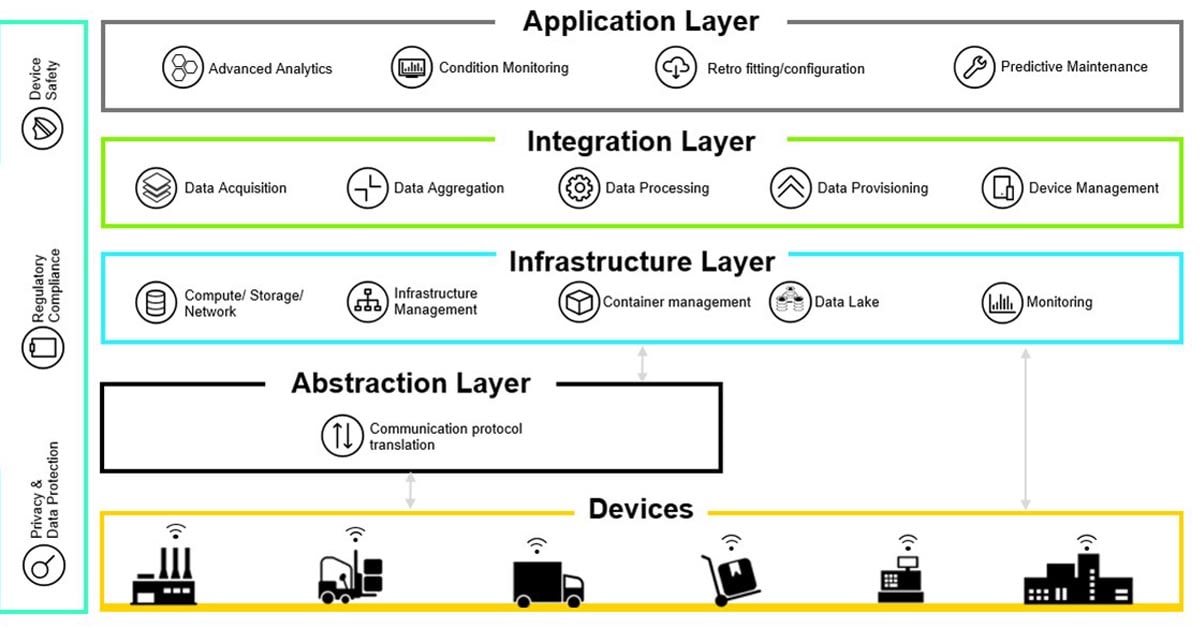The role of IoT in the manufacturing industry is increasing. Gartner forecasts 20 billion internet-connected things by 2020. Although it is not about general-purpose devices, but about dedicated-function objects, such as jet engines, connected cars or even coffee machines. Besides new business applications, IoT solutions enable businesses to analyze data generated by IoT edge devices and use these insights as a basis to improve business decisions. This article focuses on the IoT platform as one essential component of this development as well as introduces the Deloitte Digital Platform (D²P), which allows you to integrate and collaborate with data coming from various systems, devices, applications and human interaction.
What is an IoT platform?
A lack of interface and communication standards lead to a gap between IoT edge devices and business applications. An IoT platform closes this gap by acting as a middleware, which mediates between the two ends. However, modern IoT platforms go one-step further by adding functionality to the hardware and application layer. For this reason, capabilities for edge data processing or complex data analytic algorithms can also belong to the functionality set of an IoT platform. In general, IoT platforms are all about enabling businesses to build IoT solutions faster, cheaper and better, by solving problems and complexities related to the interoperability between infrastructure and business applications.
In general, IoT platforms are all about enabling businesses to build IoT solutions faster, cheaper and better, by solving problems and complexities related to the interoperability between infrastructure and business applications.
IoT platform architecture
IoT edge devices can communicate directly with the IoT platform if they support appropriate communication technology, such as WiFi, NB-IoT and Sigfox, using protocols like MQTT, CoAP or HTTPS. However, since this is often not the case, an Abstraction Layer is needed, which provides required technologies and mechanisms to translate between different protocols and communication technologies and thus mediates the data exchange.
The Infrastructure Layer includes elements that enable the general functioning of the platform. Container management solutions, the Data Lake, internal platform messaging as well as monitoring and storage solutions are located here.
The Integration Layer is mainly responsible for receiving data from the connected edge devices, processing the received data, providing the received data to business applications, and controlling devices. However, the Integration Layer is not limited to this functionality. Modern IoT platforms allow the user to add industry-specific components.
The Security Layer, which is responsible for ensuring the authenticity, security and privacy of data by enforcing protection and governance policies as well as by executing corrective controls and actions.
The Application Layer includes apps that utilize the essential IoT functionality provided by the Integration Layer to fulfill business needs. Complex data analytics, condition monitoring, retro fitting/configuration or predictive maintenance applications would be located here.

Deloitte Digital Platform
Like an IoT platform, the Deloitte Digital Platform (D²P) allows you to integrate and collaborate with data coming from various systems, devices, applications and human interaction. However, D²P does not only serve as the core of your IoT ecosystem but also of your entire enterprise, by combining and utilizing state of the art IoT, Cloud and Blockchain capabilities. Hence, the D²P is not only a middleware, it is an enterprise architecture component that impacts your whole organization and your collaboration with business partners even if they are only loosely coupled. The D²P enables enterprises to bring new business models on the road within weeks, adapt to agile development methods, reducing distributed information lakes and improve transparency. In the following the three key differentiators of the D²P will be briefly discussed:
- In order to allow the business to monitor, control and manage assets in a more powerful way, the D²P makes use of the so-called Digital Twin concept within its Integration Layer. Digital Twins provide a comprehensive digital representation of real-world assets, thus improving their state monitoring and enabling faster responses to external and internal events.
- Due to the constantly growing number of connected devices, ensuring scalability is extremely important. Use cases in which a platform needs to be able to handle thousands or even millions of Digital Twins are not uncommon. For this reason, the D²P is based on a microservice architecture, taking full advantage of the Cloud capabilities like maximum uptime and horizontal scalability using Kubernetes as an orchestration solution. The D²P is proven to be able to manage millions of Digital Twins.
- For a maximum of trust, transparency and confidence the D²P also includes the Deloitte Enterprise Trust Chain (ETC) – a blockchain based provider of digital identities. The ETC breaks through the information barriers of a single enterprise on a secure and reliable basis and protects the digital twins from unauthorized access.
Contact us

Andreas Staffen
Andreas Staffen verantwortet das Offering IoT and IT Architecture (Smart Manufacturing) für Deutschland und gestaltet die Digitalisierung der Supply Chain seit 2004. Dabei begleitet er deutsche, europäische und globale Unternehmen bei der erfolgreichen Umsetzung schlanker und integrierter IT Architekturen für die Entwicklung und Produktion. Durch die Umsetzung des Industrie 4.0 Gedanken in der Deloitte Digital Factory werden die Auswirkungen auf die Geschäftsmodelle unserer Kunden erlebbar und die weitere Gestaltung einfacher realisierbar.

Florian Ploner
Florian Ploner is Consulting Partner in Technology Strategy & Transformation. For more than 20 years he has been advising his clients from industry and technology in Europe, America and Asia on global transformation programs. Florian is a proven expert in the areas of Global Delivery, Industry 4.0, Smart Factory and Go2Market. Florian leads a strategic global technology client and the Global Deliver Network for Consulting in Germany.